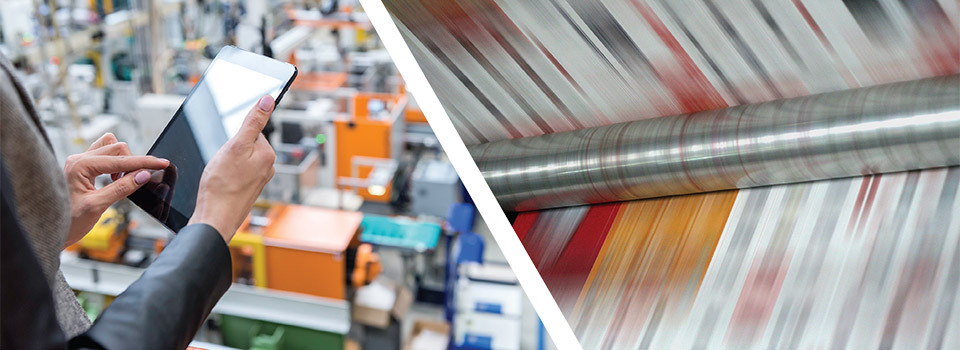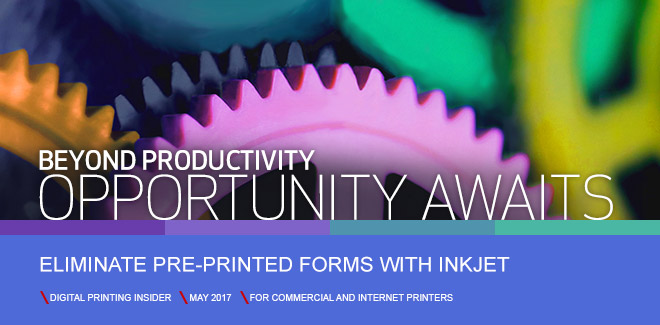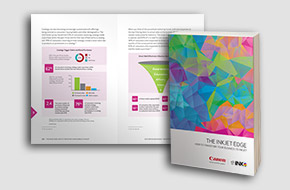Replacing Pre-Printed Forms — The Benefits of Moving to a One-Step Manufacturing Process
Variable data printing is one of the key applications for digital presses. The ability to personalize and customize content to groups of recipients, or even an individual recipient, offers tremendous marketing and customer service advantages.
Typically many variable data documents are created in two steps. First, a preprinted form or shell, usually produced on offset, is printed containing logos, branding, and other color design elements. The variable data is digitally overprinted on the offset form, often in monochrome using a digital toner device. There are a number of productivity problems that exist with this process.
Preprinted Form Inventory
Preprinted forms must be forecast, ordered, printed, and inventoried so they are in stock when needed. Preprinted forms cannot be edited. When something on a form needs to change, the existing, now obsolete, inventory is thrown away.
Production Time Delays
When preprinted forms are used, they must be picked, loaded onto the digital printer, removed from the printer after the job has been run, and re-inventoried. This not only takes time and personnel, but also errors can occur when the wrong preprinted form is picked.
Excess Costs
Preprinted forms are expensive. They cost significantly more than plain, white paper; incur the expenses of warehousing (space, lights, AC, and obsolescence); and require manual labor and printer downtime for media changes.
Turnaround Time Constraints
For many customers, a quick turnaround time is imperative. But several days of lead time may be needed to print the form on offset equipment, make sure it dries properly, cut it, and then produce the imprints.
Monochrome Variable Content
Customized marketing messages are important, but providing those customized messages in color is even more valuable. Often the use of color is limited to the preprinted form. The variable content is in monochrome. The flexibility to use the impact of color wherever needed is what marketers really want.
THE INKJET SOLUTION
Fortunately, production inkjet technology makes it possible to eliminate preprinted forms with a white-paper-in/full-color-out workflow, turning a two-step manufacturing process into a flexible, streamlined, one-step process. Such a workflow eliminates preprinted forms, eliminates the need to inventory the forms, eliminates obsolescence of forms when changes are needed, reduces time to market, lowers costs, optimizes postal spend by turning inserts into onserts, and makes it possible to deliver highly relevant messages in color.
How Does It Work?
Plain, white paper is used instead of a preprinted form. The information previously contained on the preprinted form is created in electronic form, digitally married with the variable content, and both are printed simultaneously. Using Océ PRISMAproduction® software, the preparation of the forms as well as day-to-day operations are controlled by its Professional Job Manager (PJM).
For a typical preprinted roll workflow, a static form is used for the front and back sides. Océ PRISMAproduction software allows for the selection of up to five different electronic forms for the front and back side of the paper, thereby enabling the replacement of complex preprints. For a typical cutsheet workflow, a link is set within the job ticket of Océ PRISMAproduction software between the electronic form and the respective input tray, media name, or media attribute of a cutsheet printer. A maximum of up to 16 different input trays can be defined in one job, which is similar to a cutsheet printer with 16 input trays. The software ensures that the right form is printed on the right page with the variable data perfectly aligned.
Preprinted forms to be replaced are loaded into Océ PRISMAproduction software as a PDF file. The PDF file is converted into an electronic form, after which it is available on the system whenever needed. From then on, it only takes one mouse click to change the form instead of having to change the preprinted media itself. Electronic forms can be easily edited or replaced, eliminating preprinted form obsolescence.
All the resources needed for the job reside on the print server for centralized control and print engine independence. The job can be sent to any digital print device since it is no longer media dependent to any one printer. Often several cutsheet printers can be replaced with one high performance, full color, continuous feed inkjet press without any changes to existing applications. The print job can also be sent to different locations where the electronic form can reside on a secondary server with a different fleet of printers acting as backup for disaster recovery, for meeting tight SLA deadlines, or for distribute-and-print scenarios.
Significant Benefits
One noted benefit is paper savings. A preprinted paper roll is significantly more expensive than a plain, white paper roll. Rather than stocking a wide variety of expensive preprinted cutsheet forms, one type of white paper roll paper can be substituted.
Preprinted media changes are eliminated. Assuming a daily average of three to five roll changes required by different applications, this could save 1.5?–?3 hours of downtime and manual labor per working day. Operator errors from using the wrong preprinted media and misalignment of the variable data to the preprinted form are also eliminated.

Productivity advantages of moving away from preprinted forms are one of the key reasons print service providers (PSPs) cite for acquiring production inkjet devices. One PSP had in excess of 500?–?600 preprinted offset shells that it had to procure, store, pick, and re-inventory every day. It had one client for whom it did 12,000?–?14,000 jobs per month with an average run length of 145. The PSP would pull stock every night, run the paper through its cutsheet toner printers, pull the stock back out, put it on a cart, and put it back in the warehouse. The firm did this hundreds of times per night. The total job easily took 16 hours. Now the PSP produces this job in one run. It takes one operator less than four hours a night?—?with no preprinted shells?—?just a clean sheet. Another PSP reported taking a week out of a typical production cycle after switching from preprinted forms to a one-step process using electronic forms.
Of course, cost and productivity savings translate into cost competitiveness in the marketplace. Another PSP reported finding new business opportunities for which it couldn’t previously compete by applying the two-step preprinted form/toner overprint approach. Production inkjet provided a more cost-effective option that enabled the company to compete for more business.
The ability to provide variable messaging in color can also provide a competitive edge. Offering color for both the form and the messaging provides more marketing impact, a higher-class image, and a better user experience because color clarifies information.
Another exciting opportunity is the replacement of preprinted security forms with digitally printed security documents. A variety of digital security features can open new business opportunities for secure check printing and other secure print applications like coupons and event tickets. These features include:
Digital Void Pantograph
A variety of digital security features can open new business opportunities for secure print applications.
When such documents are photocopied, the previously invisible embedded words and graphics pop out, demonstrating that the document is a copy.
Digital Verification Grid (DVG)
When using DVG, it is obvious if the document is an authentic original. Without the screened grid in the background, the document is a photocopy.
Micro-print Signature Line
This is created using micro-text, which can be viewed as text under magnification. Copying the document results in a line with gaps or will blur the text into a line that cannot be read.
Halo Covert Security
This feature instantly verifies the authenticity of any document. Only with a decoder lens can the hidden symbol or word be revealed. Another corollary option, Prismatic Print, blends two or more colors into the pantograph making it very difficult to be successfully recreated or copied.
False-Positive Testing
Using the widely available Currency Counterfeit Detector Pen, a quick stroke of the document can verify its authenticity or reveal specific content to corroborate the contents.
As you can see, the advantages of moving from preprinted to electronic forms are numerous. For more information or to determine the savings you could realize, contact your local Canon Solutions America sales representative.


